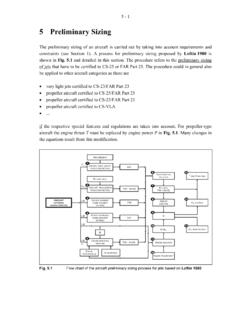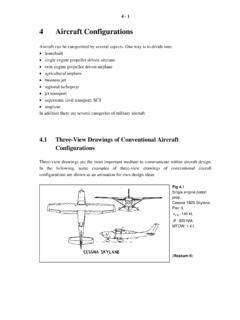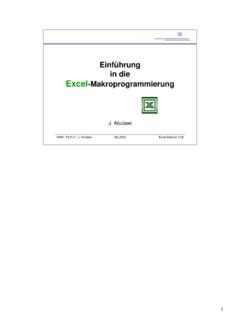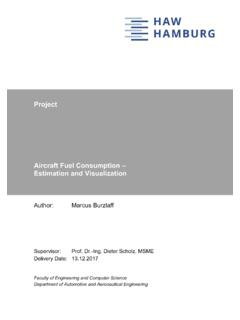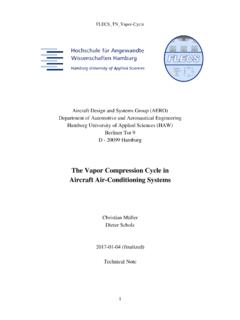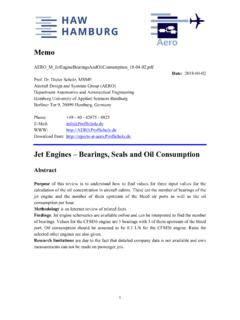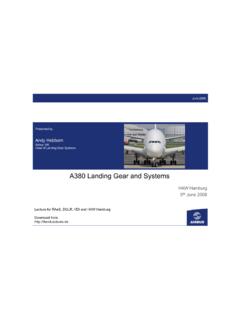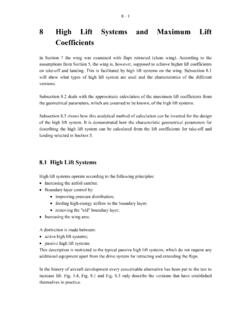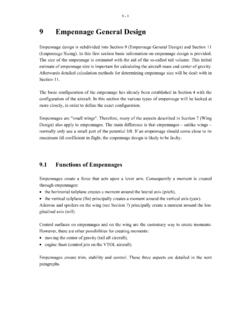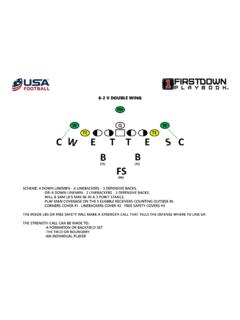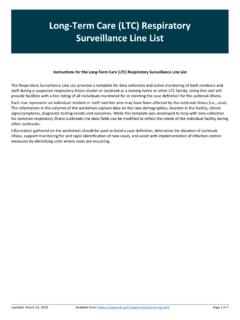Transcription of 7 Wing Design - HAW Hamburg
1 7 - 17 wing DesignDuring the preliminary sizing, the wing was merely described in terms of the wing area SW and the wing aspect ratioAW. When designing the wing , other wing parameters are determ ined. This involves the definition of the wing section and the wing ParametersFig. of the wing sectionsWing sections are positioned parallel to the plane of symmetry of the aircraft (Fig. ). A wing section is produced by scaling up an airfoil section. The airfoil section is described by the section coordinates of the top of the section yf xu=( ) and the bottom of the section yf xl=( ) with01 x.
2 Sections can also be described by the thickness distribution tf x=( ) combined with the camberyf xc=( ). Fig. contains additional parameters for describing the section geometry:Chord c Thickness tCamber ( ) /yccmaxPosition of maximum thickness xtPosition of maximum camberxycmax( )Leading edge radius rTrailing edge angle TE7 - 2 Fig. also defines the following:Chord line(Mean) camber lineLeading edgeLETrailing edgeTEFig. :Airfoil geometry (DATCOM 1978)For simplicity of production, planforms with a curved leading and trailing edge are rare.
3 Wings can therefore very often be described as double tapered wings (Fig. ). The simple tapered wing and the rectangular wing can be seen as special versions of the double tapered wing . The sweep angle depends on the % line1 on which it is measured. Normally the sweep angle of the leading edge LE, trailing edge TE, 25% line 25 (quarter chord sweep) and 50% line 50 are point where the inner and outer taper meet is called the kink. At this kink, the local chord is called ck. In contrast to the chord at the wing tip ct a chord does not actually exist on the wing root cr, but is only created by graphically extending the leading and trailing edge as far as the plane of symmetry and therefore into the fuselage.
4 The mean aerodynamic chord cMAC is the chord of an equivalent untwisted, unswept rectangular wing that achieves the same lift and the same pitching moment as this wing . The aerodynamic center, AC lies on the mean aerodynamic chord. The aerodynamic center is characterized by the following feature: if 1n% point: point on a local chord that is located n% of the local chord behind the leading line: line formed by the geometric locations of the n% points of the : In this case n% is replaced by a percentage ( 25%) or another figure symbolizing the per centage ( c/4).
5 7 - 3we take an axis that is perpendicular to the plane of symmetry of the aircraft and passes through the aerodynamic center, the pitching moment of the wing about this axis is constant and independent of the lift. The position of the aerodynamic center XAC on a rectangular wing with a thin symmetrical section is 0 25. cMAC. Torenbeek 1988 (Fig. E10) contains details of the position of the aerodynamic center on simple tapered wings. Fig. of the double tapered wingWing area SW does not just include the visible part of the wing .
6 The wing area also includes the area of the inner taper in the fuselage. The exact size of the wing area is not really import ant. All that is needed for the calculations is a standard reference wing area Sref. Why is this? Let s take a look at the calculation for lift in cruise flight, for example: mgLvCSLref == 1 22/ . If Sref is changed, only the lift coefficient CL changes (by defini tion). For this reason, aircraft manufacturers often use their own in-house definition of the (reference) wing area.
7 Fig. and Fig. show such differing definitions of the wing - 4 Fig. )Definition of the refer ence wing area accord ing to : The Boeing B-747 has a different definition of the reference wing area: Sref = )Definition of the refer ence wing area accord ing to Focker and Mc Donnell ''''2211 + +=TrapezeWingBasic:refS7 - 5 Fig. of the reference wing area according to AirbusWing parameters in aircraft designThe following have already been determined (to a large extent) (see Section 5): wing area SW wing aspect searching for a suitable aircraft configuration (see Section 4) consideration was already given to transmitting the forces from the wing to the fuselage by means of the following con figuration.
8 Cantilever wing braced wingand to the position of the wing in relation to the fuselage low wing position mid wing position high wing position7 - 6 Fig. (Positive) dihedral angle of the wingW Fig. (Positive) incidence angle iW: angle between the chord line of the wing root and a reference line of the fuselage ( cabin floor) The following still have to be determined (here in Section 7):Taper ratio, WSweep angle, 25 ,WThickness ratio, ()tcW/Airfoils Dihedral angle, vW (Fig. )Incidence angle, iW (Fig.)
9 wing twist, t (Fig. )Subsections and below contain equations and estimates for these parameters. It is im portant to compare and check the calculation results with the values from the aircraft statistics. Tables with wing parameters are, for example, included in Roskam II (Section 6) and Toren beek 1988 (Section 7). Further comprehensive information can be found in Jane's All The World's Aircraft (Lambert 1993).7 - 7 Fig. twist t. The twist shown in the diagram is negative. There are two types of wing twist: 1.
10 Geometric twist:change in the angle between the chord ) Aerodynamic twist:change in the zero-lift line along the span of an diagram shows the typical case of reduced lift at the wing tip, wash out . The opposite effect is called wash in .The following must be taken into account when choosing parameters: Take-off/landing: maximum lift coefficient, required high lift systems, lift-to-drag ratio, at titude, lift curve slope dCdL/ Cruise: lift-to-drag ratio L/D, drag divergence Mach number MDD, buffet onset boundary Fuel tank volume Flight characteristics, stalling behavior, flight in turbulence Landing gear actuation and stowage wing mass Production costsThese characteristics, which depend on the choice of the above-mentioned wing parameters, are discussed in Subsection DefinitionsAspect ratioAbS=2 ,( )with Span aerodynamic chordcSc dyMACb= 2202/ ,( )7 - 8 AreaSc dyb= 202/ ,( )
